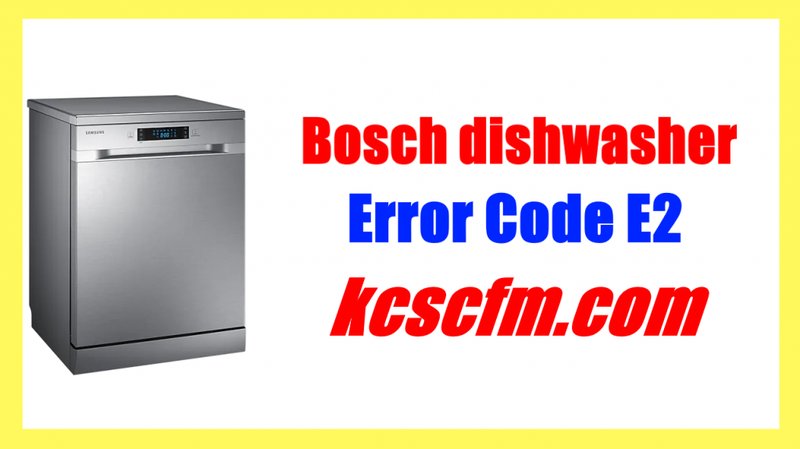
When your Bosch dishwasher displays an Error Code E2, it’s essentially trying to let you know there’s an issue with the machine’s heating element. Think of the heating element as the heart of the dishwasher, ensuring that the water reaches the right temperature for optimal cleaning. Without the right temperature, your dishes might not come out as spotless as you’d like. This could be akin to trying to wash greasy pans in cold water—not as effective, right? Let’s delve into what causes this error and how you can tackle it.
Understanding the Role of the Heating Element
Before jumping into fixing Error Code E2, it’s helpful to understand the role of the heating element in your Bosch dishwasher. This component is crucial for maintaining the hot water temperature needed to dissolve detergents effectively and to ensure your dishes emerge both clean and sanitary. Imagine trying to wash clothes in cold water without detergent—incomplete and unsatisfactory, right?
When the heating element is functioning properly, it heats the water during the cleaning cycle and also helps dry the dishes by ensuring water evaporates quickly. If there’s a hiccup with this component, it can prevent your dishwasher from reaching the right temperature, thus triggering Error Code E2. This not only affects cleaning efficiency but can also extend the washing cycle duration as the machine struggles to maintain the necessary heat.
Knowing this, it’s clear why a malfunctioning heating element needs prompt attention. Luckily, understanding the possible causes can aid in resolving the issue effectively. Whether it’s a minor glitch or a sign of a worn-out part, identifying the cause is key to fixing the problem.
Common Causes of Error Code E2
Now, you’re probably curious about what specifically might cause this crucial component to fail. Several common reasons can trigger Error Code E2. Firstly, a common culpit is a faulty wiring connection within the dishwasher. Over time, wires can become loose or damaged, especially with the constant vibrations and temperature changes that occur during the wash cycle. Loose wires can interrupt the power supply to the heating element, causing it to fail temporarily or permanently.
Another potential issue could be a burnt-out heating element. Much like a lightbulb that has reached the end of its lifespan, the heating element can also burn out after prolonged use, particularly if the dishwasher is frequently used. This wear and tear can result in its inability to heat water effectively, thus triggering the error code.
Additionally, the thermostat or control board might be malfunctioning. These components are responsible for regulating the temperature and controlling the heating process. If they fail, they can miscommunicate with the heating element, causing it to either underperform or stop working altogether. Each of these issues requires careful examination and sometimes professional repair or replacement.
Steps to Diagnose and Fix the Error
So, what should you do if you’re faced with Error Code E2? First, try the simple tricks. Sometimes, turning off and unplugging the dishwasher for a few minutes can reset the system. It’s like giving your computer a quick reboot when it’s acting up. If this doesn’t work, you might need to roll up your sleeves and inspect further.
Begin by checking the wiring connections to see if they’re intact. If you find any loose or damaged wires, securing or replacing them might solve the problem. If you suspect a burnt-out heating element, you may need to test it with a multimeter—a tool that measures electrical current. If the element shows no continuity, it’s usually time for a replacement.
For thermostat or control board issues, contacting a professional is often the best option. These parts are more complex and require specialized knowledge to address effectively. However, understanding that they are potential culprits can help you communicate better with a repair technician.
Tips for Preventing Error Code E2
Preventing Error Code E2 can save you time and trouble in the long run. Regular maintenance goes a long way. Periodically inspect the internal components like wiring connections and clean the dishwasher to prevent residue build-up that may cause overheating or damage.
You can also consider running your dishwasher on different cycles to ensure all parts, particularly the heating element, are used regularly and have a balanced workload. If your dishwasher seems to be running too long or not heating properly, addressing these symptoms early can prevent a full-blown error.
In conclusion, while Error Code E2 might seem daunting at first, it’s often a signal for you to give a little attention to your trusty dishwasher. With a bit of inspection and occasional professional help, you can keep it running smoothly for years to come. And remember, keeping your Bosch dishwasher in tip-top shape is as beneficial to it as a regular check-up to maintain your car’s health.